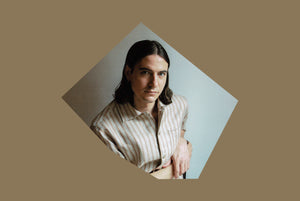Life With: Alexander V. Ottenstein

Life With: Alexander V. Ottenstein
Finding it difficult to decide on what to study, Alexander found architecture to be the perfect hybrid between all common interests. Professionally, he is working with his partner Mathias Mentze, their latest project being the newly opened Sofi Bakery in Berlin.
ANOTHER ASPECT:
Tell us about how you first became interested in Architecture?
ALEXANDER:
I have always been the type of person who liked to acquire new skills. As a kid I would spend all my time being the nerd who would try to master every little subject, like learning a new language, or trying out 3d modeling software, or figuring out how to do computer programming. That also meant that when I was figuring out what I wanted to study, I had a really hard time deciding, because there were just so many different things I found interesting and rewarding. At some point I realized that architecture school would be perfect - this too is about acquiring a huge set of very different skills and learning to apply them to a specific subject. So in the end, it was more about the methodology of the subject than about the contents of the subject itself.
ANOTHER ASPECT:
Comparing architecture practices of today with that of past generations, how do you think the approach to architecture has changed? And why?
ALEXANDER:
I think architects have become less god-like figures, and instead are having to operate on equal terms with a large array of other professions. You see this for instance in the realm of architecture competitions. Back in the days, whenever there would be a big new public commission, architects from all over the world could hand in a project anonymously, like a big beautiful model and a few drawings, and the bid would be awarded to whoever had made the project that resonated best with the committee on that specific day. Today, more often than not, the architecture studio has to put together a team of building architects, landscape architects, structural engineers, energy and resource management engineers, anthropologists, biodiversity specialists, you name it, in order to be awarded the right to even participate in the competition. I think good and bad things come from this practice, but of course, there's no doubt that no single profession or person should get to operate as a god.

ANOTHER ASPECT:
When you begin on a new project, what is the most important part you need to have in place before creating?
ALEXANDER:
I always start out making a highly detailed (and time-consuming) survey and modelling of the existing conditions of the place. We measure out every single room, opening, skirting panel or whatever, and add it into our 3d model of the place. This has both a practical and a more immaterial use. The practical reasons are that, for me, the more detailed a set of drawings and models I have before we start doing anything to the place, the easier it is to just dive right into it. The more abstract reason is that through the process of measuring out or surveying a place, you learn all sorts of things that you would not be able to see just by snapping a few pictures. It's a sort of ritual that you need to go through each time before you are able to get to work on the assignment.
ANOTHER ASPECT:
How much research does a new project take? And where do you find your inspiration?
ALEXANDER:
For us, research is the foundation of every project. We like to apply a sort of archaeological practice, where we scrape back the layers, abstract or not, of a place, and figure out what are the interesting narratives here and how can we apply them in the design process or communicate them in the project. Another thing to realise is that, the role of an architect is not necessarily to be the most inventive or gimmicky person in the room, but instead be the one to look closely at a place in order to realise what is already there and what few things need to be added or removed.

Alexander wears ANOTHER Shirt 2.1, Night Sky Navy (see more) & ANOTHER Pants 2.0, Antique White (see more).
ANOTHER ASPECT:
What material would you never use for your work?
ALEXANDER:
I don't think I would ever rule out a single material, but I will say that so far my interests have been more towards the traditional. Some of it again points back to the "architecture is not about invention or gimmick"-credo. Like, if cabinetmakers and carpenters have been making chairs out of wood for centuries, that must mean that wood is a perfectly suited material for exactly that.
ANOTHER ASPECT:
What do you usually wear for work?
ALEXANDER:
These days I like to look like it's not completely certain if I'm on my way to a business meeting or to a lunch in a summerhouse, meaning that I dress up the casual, and dress down the formal. This I believe is perfectly encapsulated in my way of wearing a shirt - I only tuck one side of it. A friend of mine has dubbed it my "one-sided french tuck". It goes with everything, and it makes shape-shifting quick and easy: if suddenly you do find yourself at a business meeting, you just tuck the other half, or if on the other hand you unexpectedly happen to be situated at the summerhouse lunch table, you just untuck the whole thing.
 Alexander wears ANOTHER Shirt 2.1, Night Sky Navy (see more) & ANOTHER Pants 2.0, Antique White (see more).
Alexander wears ANOTHER Shirt 2.1, Night Sky Navy (see more) & ANOTHER Pants 2.0, Antique White (see more).
